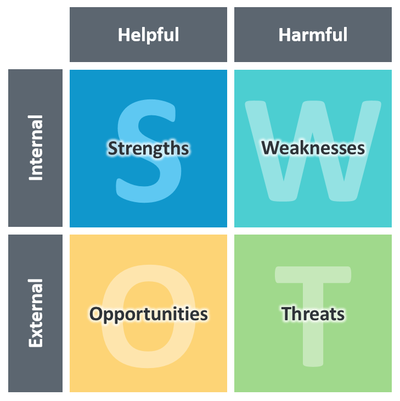Tools and Training
SWOT Analysis
On this page:
What is a SWOT analysis?
How to conduct a SWOT analysis
Examples
More information
What is a SWOT analysis?
A SWOT analysis provides programs and organizations with a clear, easy-to-read map of internal and external factors that may help or harm a project, by listing and organizing a project's strengths, weaknesses, opportunities, and threats. SWOT can clearly show a program its chances for success, given present environmental factors.
How to conduct a SWOT analysis
Create a chart with columns titled "Helpful" and "Harmful," and rows titled "Internal" and "External."

Sort out factors that impact your organization, and place them in the appropriate rows/columns:
| HELPFUL (positive impact) | HARMFUL (negative impact) | |
| Internal | Strengths may include:
| Weaknesses may include:
|
| External | Opportunities may include:
| Threats may include:
|
Remember:
- Try to look at your organization from an external perspective, even when assessing internal factors: What would others say about your organization?
- Try to verify/quantify statements when possible, rather than making general statements about your strengths, weaknesses, opportunities, and threats
- You may end up with what seems like too many factors to consider, at which point it might be helpful to start prioritizing them
- Consider: How can you convert weaknesses into strengths? Use strengths to overcome threats? Use strengths to maximize opportunities? Use strengths to compensate for or minimize weaknesses?
- SWOT analyses can be performed on multiple levels of an organization: Might it be more helpful to perform one just on your program? division? a specific process?
Example SWOT analyses
Community Leadership Team SWOT Analysis (PDF)
Meeker-McLeod-Sibley Community Health Board
This SWOT analysis was conducted by Meeker-McLeod-Sibley in 2008, to inform development of a community leadership team within its SHIP-funded Healthy Communities Collaborative.
Appendix D: SWOT Analysis Results from Technical Teams (PDF)
ASTHO
St. Cloud State University Strategic Plan: SWOT Analysis
St. Cloud State University
More information
SWOT Analysis
Mind Tools
How to Perform SWOT Analysis
Bplans.com